HR analytics software solutions may provide organizations with information to get a full picture of their workforce. This information can turn into actionable workforce insights in order to potentially improve diversity initiatives, employee retention, recruitment and training. We've curated a vetted list of the top HR Analytics Software solution providers in 2024 to help you find the right HR analytics software for your organization.
By analyzing employee data, HR analytics software can help businesses identify trends and patterns related to employee behavior. This information can be used to improve HR policies and practices, and to make better decisions about employee retention, recruitment and training. After all, HR data is the infrastructure of a top-notch employee experience.
For automated HR analytics and data visualization software solution, this list is highlights the top people analytics solutions from top to bottom. Explore the pricing (as-available), value, and organization headcount size.
The teams behind the people analytics solutions below have all worked with many organizations to bring their HR departments and their business into the future.
Effectively reshaping HR reporting processes allows businesses to thrive while management is equipped with greater insight into how employees reach new levels of satisfaction and productivity. It can save up to 1 day per week for HR Generalists/HR Directors and is similar to using an automated solution vs. manually creating Excel-powered HR dashboards.
Automated HR Dashboard solutions support several HR Platforms, including the most popular like Greenhouse, BambooHR, and Zenefits, among other Applicant Tracking Systems (ATS), HR Information Management / HR Management Systems (HRIS'/HRMS), payroll, benefits, employee experience, and engagement systems, and more.
For example, you can see ADP's solution by watching this People Analytics and DEI Workshop. Take 44 minutes to find out the best ways to collect DEI data, analyze it, and make it transparent by communicating insights gleaned from DEI data to support your DEI goals.
Often these HR solutions do include their HR dashboard built into the product. Still, it is not a focus area to provide advanced HR analytics for them using these HR systems, so if you want a more specialized HR analytics dashboard and HR reporting solutions, you should go with a purpose-built, automated HR dashboard solution such as the ones mentioned above.
Find more HR analytics articles and webinars here. And be sure to subscribe to our weekly HR newsletter to be the 1st to get new information on upcoming HR webinars, new articles, guides, and HR courses.
The pandemic has forced us to rethink work in a post-pandemic world. We've seen a shift to hybrid and remote work, inclusion initiatives, and engagement. HR and People Operations leaders like yourself are looking for ways to learn, share, and connect as we tackle the biggest challenges facing HR in a fast-changing future.
The Top 11 HR Trends to Watch are: hybrid work, inclusion, engagement, employee experience, remote work, human-centered HR technology, compensation innovation, career development, advanced people analytics, pay-for-performance, and employee wellbeing and mental health in the workplace.
As we move into the new year, it's important to keep an eye on the latest HR trends. Here are the top 11 HR trends to watch:
As more and more companies adopt hybrid work models, HR will need to adapt to this new way of working. It is a compromise to calling back your workforce to the office who may still be fully working remote. Examples of these models include floating hubs, centered hubs, and slanted hubs. Use these models as a starting point to design an employee experience that supports this new way of working. And trust needs to go both ways for the Hybrid work model to take place.
Hybrid work lets you have more freedom while still staying connected, which is what a lot of workers want today. However, hybrid work is still a work in progress. If leaders work with employees to make it more human, it can be the best of both worlds. Recent data back this leading trend up:
For ideas on how to implement Hybrid, see the piece on 4-day workweeks, which discusses rotational days off and more.
Inclusion has emerged as the number one business imperative for HR leaders. The pandemic has created unprecedented levels of diversity in the workforce by expanding access to remote workers across the country and world—whom may have never been considered before. And with the growing focus on inclusion and diversity in the workplace, HR will need to ensure that all employees feel included and valued.
Not long ago, the ROI on inclusion to be massive by HBR:
Be sure to start with human-centered work practices that recognizes employees for their positive efforts and work. As people leaders, we need to ask ourselves: “How might we take care of this new workforce?"
Inclusion naturally also involves a multi-generational workforce and provide benefits to them as well. That inclusive spirit should extend to how organizations deal with change. How do we include those that don’t want to change? How do we include all the different people in our organization and still drive change? That’s a huge challenge and a massive opportunity for organizations.
Employee engagement is key to a successful workplace. And with 70% of employees surveyed in the latest Workforce Institute’s Engagement and Retention Report stating they would be looking for new jobs, it could mean major turnover.
While employee engagement has been a buzzword for years, it has recently grown in importance. There is increasing evidence that shows a correlation between engaged employees and better business results. It's important to note, however, that employee engagement and employee experience (EX) are not the same thing. As Christie Hoffman, host of the Flip Flops and People Ops podcast explains it:
"Engagement is an output of optimizing your employee experience. By listening to your people with surveys and taking action on their feedback on what it's like to work at your company, you'll drive engagement."
Christie Hoffman, Head of Product Marketing at Pingboard and Host of Flip Flops & People Ops
As companies implement more AI and automation, they will increasingly rely on human engagement to successfully launch and grow these initiatives. Therefore, HR leaders must seek ways to learn, connect, and share knowledge as they confront the most significant challenges facing HR in an ever-changing future.
Better engagement can lead to increased productivity, lower turnover, greater customer satisfaction, and better retention of knowledge and skills. As a result, HR must find ways to keep employees engaged and motivated. Depending on your business requirements, platforms like Lattitude, Culture Amp, and Pingboard can help you achieve this.
It is table stakes to prioritize your employees' experience within your organization. Employee experience (EX) has been a key topic of discussion in recent years. However, there is still some confusion about what it actually entails, and the difference between EX and employee engagement as Christie mentions above. From attracting top talent to onboarding and beyond, employee experience encompasses the entire employee lifecycle.
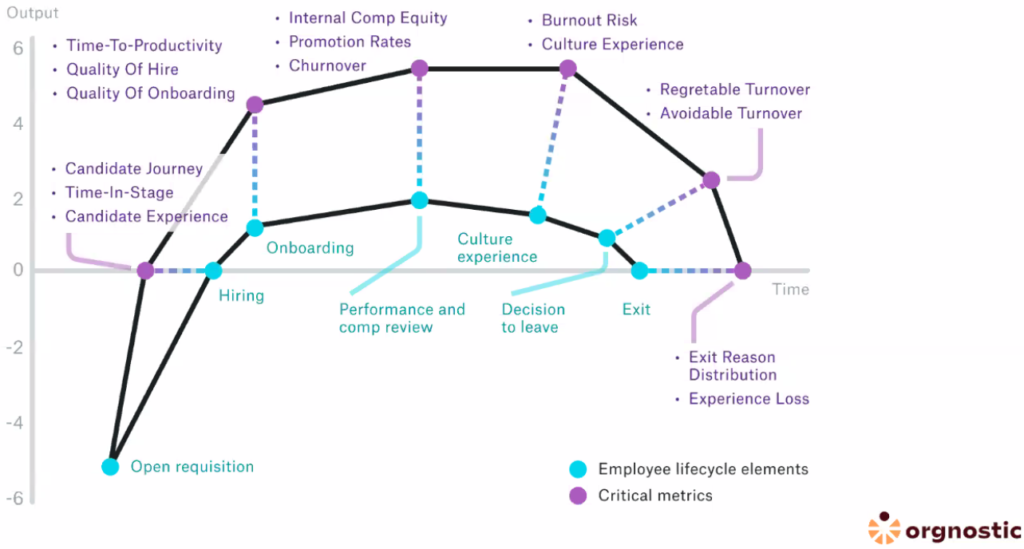
The best brands create incredible employee experience by creating a culture of great service for their customers and clients—and this starts with our employees. This extends to the workplace and how you manage benefits, compensation, and culture.
Looking to transform employee experience at your organization? Explore our 2-minute micro-course on EX transformation best practices.
With more and more employees working remotely, HR will need to find ways to support this growing.
The number of full-time employees that work entirely remote reach new highs, but not as much as 2020 during the start of the pandemic due to the return to the office and especially hybrid work. Regardless, remote work is here to stay forever.
According to a Ladders research, projections that 25% of all professional jobs in US and Canada will be remote by the beginning of 2023. This recently increased to 36% in its Q3 2022 Quarterly Remote Work report.
With the cost of living increasing and housing costs skyrocketing in many cities, remote work is continuing to be possible for more people. There are even some situations in which it is required, such as when an individual or their child are ill and need special care. The requirement to be physically present at work is becoming less normal than it once was.
Working remotely offers many benefits, including a lower cost of living, greater personal time management, and enhanced work/life balance. It can be a better work-life blend and improve the quality of life for employees and their families.
Systems and tools for HR will continue to transform the way we work. From talent acquisition, workforce and HR analytics, job bots, new applicant tracking systems (ATS) and job boards, to AI-powered solutions and more.
HR technology is a critical component of the modern People Leader in the digital workplace. It’s not surprising that an overwhelming majority (85%) of the HR professionals surveyed said they plan to invest in or already have invested in AI-powered HR solutions.
Technology may even have the power to enable AI-first organizations to grow at even greater speed. From Learning & Development, such as an AI-powered micro-course authorship technology. We use it to create training and development course materials — and you can give it a spin with a free 14-day trial from our affiliate 7taps. See our micro-courses for HR here for examples.
While the good news is that pay satisfaction is at an all-time high, the fact remains that many organizations did not change their compensation plan in 2022. Compensation salary plans, executive pay and compensation, and the overall compensation structure is ripe for innovation. Coupled with performance evaluation trends, HR expert Harold Strong, MBA spoke with us about this need recently.
"New performance evaluation strategies are needed, and should factor in that to be attractive to potential future talent, and to retain top performers—a lot needs to happen."
Harold Strong, MBA, Human Resource Consultant & Adjunct Business Instructor
The good news is that compensation is not at the top of the list of why employees leave organizations; it is #3, right behind how their manager treats the employee, and the lack of upward career mobility via promotions. That said, 75% of employees say they would leave their job if they were offered a salary increase. This means that your compensation strategy needs to be improved if you don't want to lose your employees.
Career development refers to the planning and programs that help employees grow both within a given role and within the company. Consider a mentorship program to match people in your organization up with others across departments. It's proven that accessing talent through mentorship will give your employees the career development they need.
"Going into a new role, guns blazing and trying to make changes before truly understand what is happening and what is needed. Be honest with yourself 'I don’t know everything. I don’t know everybody. I don’t know really what the most important things are not going to change every single thing.' Seeking first to understand is paramount to influence any kind of change, any kind of development, any kind of transformation, organizational, cultural change. Being sponge mode first, whenever you get into these new scenarios and situations."
Pete Schramm, CEO at Lattitude
Related: explore the Good Jobs Guide
The forward-leaning HR leader will not only deploy, but also integrates and uses human resource analytics to better understand, predict, and improve performance. As HR departments in remote-first and hybrid workplaces evolve, we are seeing an increasing use of data-driven approaches. After all, data is the infrastructure of employee experience. And HR data is a prerequisite for employee experience transformation, according to Luka Babic of people analytics platform Orgnostic:
"HR remains the only sort of feeling-driven function — and that isn't ideal because it is not being factored properly by the rest of the executive leadership team and to an extent the result of talent as well. And I think that's the kind of a chasm — HR leadership needs to adopt this kind of mindset, that we need to build a data-driven function... because management is usually appreciating that kind of approach."
Luka Babic, co-founder and CEO of Orgnostic
For quickly getting your HR analytics to the next level, consider one of these Top 10 HR dashboard examples you can use today.
The global pay-for-performance index indicates that nearly a third of organizations do not have a pay-for-performance strategy, while 53% have a moderate to high level of compensation variability. For companies who want to drive higher performance, the question is “How?” not “Should we?”
The importance of employee wellbeing and mental health in the workplace is crucial, particularly in a 'post-pandemic' environment, and employers can take steps to support their employees' mental health by providing access to resources and creating a culture that normalizes seeking help. As HR leaders, it is essential to prioritize mental health and promote a culture of support in the workplace to protect and strengthen the health and safety of all employees.
Along with the top 11 HR trends to watch, including hybrid work, workplace inclusion, employee engagement, employee experience, remote work, HR technology, compensation innovation, career development, advanced workplace analytics, and pay-for-performance, employee wellbeing and mental health must be at the forefront of HR initiatives.
Thanks for reading my 1st annual HR tech trends report! For even more explore what The Future of Work looks like and this read on Re-imagining the Workweek.
The COVID-19 pandemic has highlighted the importance of prioritizing mental health in the workplace. As we navigate the new normal, employers must take an active role in supporting the mental health and wellbeing of their employees. In this article, we will discuss the importance of mental health in the workplace and provide tips for employers to help support their employees' mental health.
Mental health affects everything we do, from our ability to work to our relationships with others. The workplace can be a particularly stressful environment, with high demands, long hours, and tight deadlines. When employees are stressed and overwhelmed, their mental health can suffer, leading to decreased productivity, increased absenteeism, and even physical health problems.
Employers have a responsibility to create a supportive and inclusive workplace that prioritizes mental health. By doing so, they can not only improve their employees' mental health but also increase productivity, decrease absenteeism, and improve employee retention.
Creating a positive work environment is essential for promoting mental health in the workplace. Here are some tips:
Employers should provide mental health resources to their employees, including:
Flexible work arrangements can help reduce stress and improve mental health. Here are some options to consider:
Educating employees on mental health can help reduce stigma and promote help-seeking behaviors. Here are some ways to educate employees:
There are many resources available to help employers support their employees' mental health. Here are a few:
Prioritizing mental health in the workplace is essential for creating a supportive and inclusive work environment. Employers have a responsibility to provide mental health resources, create a positive work environment, offer flexible work arrangements, and educate employees on mental health. By doing so, they can improve their employees' mental health and wellbeing, leading to increased productivity, decreased absenteeism, and improved employee retention.
For even more, explore our additional resources on this important topic that may help you boost and prioritize your employee's wellbeing (and that of your own):
In today’s digital age, companies are growing at a rapid pace and managing a distributed workforce. With more employees working remotely or in hybrid settings, companies need to ensure that their workforce is happy, engaged, and productive. To achieve this, companies are turning to an employee experience platform (EX platform). In this article, we'll explore the benefits of an employee experience platform and how it can help maximize your human capital.
An employee experience platform is a technology platform that captures employee data and provides people analytics. It is a central repository of employee data that tracks an employee's lifecycle with the company, from onboarding to offboarding. An EX platform collects data on employee engagement, performance, feedback, compensation, and more. It is a single source of truth that can be used to make data-driven decisions to improve employee experience.

An employee experience platform is designed to improve employee engagement. By capturing data on employee engagement, an EX platform can help identify areas of improvement, such as communication, recognition, or career growth. With a better understanding of employee needs, companies can create a more engaging work environment and reduce employee turnover.
Employee performance is critical to the success of any business. An employee experience platform can help managers identify top performers and those who need additional support. By tracking performance data, managers can provide targeted feedback and coaching to improve employee performance. EX platforms also help with goal setting and tracking to ensure that employees are aligned with company objectives.
Onboarding is a crucial process for new hires, but it can also be time-consuming and overwhelming for HR and managers. An employee experience platform can help streamline the onboarding process by providing new hires with everything they need to get started, such as company policies, handbooks, and benefits information. By automating the onboarding process, companies can save time and ensure that new hires are up to speed quickly.
Performance reviews can be stressful for employees and managers alike. An employee experience platform simplifies the process by automating the review process and providing a centralized location for all performance data. Managers can provide feedback in real-time, and employees can track their progress throughout the year. By simplifying the performance review process, companies can reduce stress and anxiety and improve employee satisfaction.
An employee experience platform provides employees with a personalized experience. With an EX platform, employees can access information on their performance, benefits, and career growth. They can also set goals, track their progress, and receive feedback in real-time. By providing employees with a personalized experience, companies can improve employee engagement and retention.
An employee experience platform captures vast amounts of data, which can be used to make data-driven decisions. With people analytics, companies can analyze employee data to identify trends, such as employee engagement or performance issues. By having access to this data, companies can identify areas of improvement and make informed decisions to improve employee experience.
An employee experience platform provides companies with the flexibility to adapt to changing business needs. With a centralized location for employee data, companies can quickly respond to changes in employee needs or business objectives. By having access to real-time data, companies can be more agile and respond to changes quickly.
An employee experience platform can help companies stay compliant with labor laws and regulations. By capturing data on employee demographics and job responsibilities, companies can ensure that they are meeting legal requirements for hiring, benefits, and compensation. With an EX platform, companies can reduce the risk of compliance issues and avoid costly penalties.
Better communication is a key benefit of an employee experience platform as it enables employees to easily connect with each other and their managers. With a centralized platform, employees can stay up to date on company news and initiatives, receive real-time feedback and coaching, and have access to valuable information such as job descriptions, performance plans, and compensation packages.
Investing in an employee experience platform offers multiple benefits for your business, including:
An employee experience platform eliminates the need for manual data entry, as it automates repetitive HR tasks such as onboarding, performance management, and benefits enrollment. It also serves as a centralized hub for all HR-related activities, giving your HR team more time to focus on strategic initiatives.
Employee engagement is critical for business success, and an employee experience platform can help you achieve this. By collecting data on employee feedback, experiences, and preferences, you can identify areas for improvement and address employee concerns in a timely manner. Engaged employees are more productive, innovative, and loyal, which translates to better business results.
People analytics refers to the use of data to gain insights into the workforce, such as employee performance, engagement, and retention rates. An employee experience platform provides a wealth of data that can be used to improve business decision-making. With accurate data and reporting, you can create and implement HR policies and strategies that are informed by real-time insights.
An employee experience platform can help create a personalized development plan for each employee, based on their career goals, strengths, and areas for improvement. With this information, you can create customized training and development plans that will help employees grow and develop their skills.
Employee retention is vital for business success. Retaining top talent saves money and time spent on recruitment, and helps ensure continuity of knowledge and experience. An employee experience platform can help you identify potential issues that may lead to high turnover rates, such as poor performance management, lack of training and development opportunities, or compensation issues. By addressing these issues, you can increase employee satisfaction and retention rates.
A positive company culture is crucial for attracting and retaining top talent, and an employee experience platform can help foster a culture of transparency, communication, and collaboration. With features such as team building exercises and individual feedback tools, you can create a work environment where employees feel valued, supported, and motivated to do their best work.
In a digital-first world, many businesses have shifted to remote work models. An employee experience platform provides a platform for remote employees to access HR-related resources, collaborate with colleagues, and receive personalized training and development opportunities. This helps ensure that remote employees feel connected and supported, even when working from a distance.
Investing in an employee experience platform is an investment in your business’s human capital. By streamlining HR processes, improving employee engagement, enhancing people analytics, encouraging personalized development, increasing employee retention, boosting company culture, and supporting a remote-first workforce, you can create a positive work environment that fosters growth, innovation, and success.
Maximize your human capital and transform your business practices by investing in an employee experience platform today. Some of these platforms often go by the name of People Analytics Software and the field is ever-evolving.
For even more, we's prepared several micro-courses where you can learn Employee Experience best practices for your organization's EX transformation initiative, and a foundational course on Human-Centered Work Culture.
Take one work day to advance your People Analytics - also refererred to as HR Analytics - entirely free from current and former CHROs and people ops execs from companies like instacast, WesternUnion, American Express, Uber, and Facebook.
The free online HR courses ended June 29 2022 but recordings of all the sessions are available (Register to learn HR analytics).
When: On-demand
Price: FREE
Who: this People Analytics course series is not a course on statistics, Excel, R, or Python. Its goal is to help (striving) CHROs learn how to set good people analytics foundations, build HR strategy and tell the story behind your organization's people data.
Set the right People Analytics foundation
Assemble the tech stack and design the workflow to incorporate People Analytics in your day-to-day work (even if it seems impossible to fit into your current schedule).
Connect HR metrics to business goals
From interpreting HR metrics to weaving stories, learn how to find the golden nuggets in your data — and convey the value to the executive team clearly.
Develop and implement a data-driven HR strategy
Acquire the confidence to plan and execute strategic initiatives, create experiments, and steer your team toward adopting a data-driven HR culture.
The series consists of 8 masterclasses that will teach you everything from people analytics foundations to creating and implementing data-informed HR strategies:
Each session includes an optional multiple-choice quiz. You will also receive one optional assignment that should enable you to create a data-driven strategy by the end of the series.

The People Analytics Masterclass is brought to you by Orgnostic – the people analytics platform for strategic HR leaders. We’ve created this course because we’re on a mission to democratize people analytics and make data-informed HR practices readily-available to any organization that cares about its people.
Yes, if you complete quizzes for more than 80% of the sessions by 15 July, 2022, you will get a certificate.
Yes, you can add this series to your calendar here.
You don’t have to attend all sessions if your schedule doesn’t allow it or you don’t find some topics to be useful. Just skip to the ones you are interested in and book your calendar.
No worries, you will receive recordings of all the sessions so you can watch it at a time that works for you. We still recommend that you attend the sessions live to be able to make use of the Q&A session.
Only if you want to.
The quizzes are a short summary of each session and a good way for you to double check if you remembered the most important learning points.
The assignment should enable you to use what you've learned in your day-to-day work after you've completed the series.
They currently don't offer HRCI credits towards HR certification, but attendees can self-report to receive recertification credit.
This course has been brought to you by Orgnostic, a people analytics software for strategic HR leaders. They help HR and people ops leaders get people analytics initiatives off the ground. Link your scattered HR data, run surveys on top, and get answers to the critical questions about your people in minutes.
Now more than ever, it is essential for companies to have an easy-to-access, easy-to-understand, single, real-time view of all of their HR data. This access allows CEOs to make accurate revenue projections and realistic budget decisions. It also helps administrators, hiring teams, recruiters, and managers make better on-the-ground decisions.
Many companies are still stuck in the Human Resource processes of decades ago, with paper files filling filing cabinets and HR staff buried up to their necks, with many of their hours being spent rifling through paperwork and compiling reports from various applications like Excel, sometimes printing reports out for top management only to then try to make sense of them or discover calculation errors with the analytics charts. Sometimes, they simply hand those HR reports off and rely on executives to make that sense. Unfortunately, making sense of dozens of different and disparate data points can feel overwhelming, and a lot of critical data slips through the cracks. An HR dashboard will streamline and simplify this entire, decades-old headache and keep data and people from slipping anywhere.
First, it is necessary to understand what an HR dashboard (also known as a people analytics dashboard) is. Most HR departments, at the behest of management, are tracking various pieces of information about the people who make it up. For both employees and contractors, and seasonal employees and PT workers alike.
Important HR metrics include, but are not limited to:
If that list seems extensive, that’s because it is! Recruiting, interviewing, hiring, training, employing, and even firing or losing people provides a company with tremendous information. Understanding that information and acting on it correctly can help your business grow, succeed, and thrive. Misunderstanding can lead to failure and destroy a company and its work culture.
An HR Dashboard brings all that data, everything on that list, and more into a single view, just like your car's dashboard. It can interface with multiple applications your HR department may be using and compile all the data from all those apps into one streamlined screen for you.
Aside from the obvious convenience, why do you need an HR dashboard? Maybe you feel confident about your company's direction and don’t think an HR dashboard is necessary.
An HR dashboard streamlines your HR processes and lightens the labor load on your HR team. This relief means you can better capitalize on your human capital. You can put your team to better use than reading and compiling paper reports for weekly management meetings.
Your HR team is better used to working with your people, settling conflicts, and recruiting, interviewing, and hiring quality personnel. The less we can keep the HR department buried in data and paperwork, the better.
Your Key Performance Indicators include headcount and the rates of turnover, promotion, and retention to maintain a strategic workforce. As CEO, top executive, or manager, your goal is to focus on the bottom line. You also want to drive sales and ensure excellent service or product delivery. To do that, you must ensure your entire team is on board, well-trained, and equipped to compete in an increasingly digital workplace environment. How do you do that?
When you understand, value, and develop your human capital through effective utilization of your HR Dashboard, you know each team member you have is playing to their strengths and that you are helping them develop their weaknesses. Your KPIs will practically take care of themselves. Strategic visibility of the workforce will become the status quo.
For HR business partners and the internal HR team, creating, maintaining, and sharing accurate and fresh HR reports for strategic visibility across the organization to stakeholders and management is imperative.
Once you implement an HR dashboard into your Human Resources department, your People Operations leaders can get a single, real-time view of all of your HR data. With an HR dashboard, such as a cloud-based HR dashboard solution, all of your HR data will transform into data stories, providing a full picture of what is at stake in your company.
HR Executives and HR Managers can then translate those stories for management and CEOs with adequate data on hand, so management can make the necessary changes and shifts within the organization to meet KPIs in real-time. Not after every quarterly report.
With HR Dashboard software, top management can expect data collected into a single database for easy and accurate report creation. This translates into:
So you’re ready to get started? You can create your own with Excel Spreadsheets.
The Excel template is free and ready to create your HR dashboard. Download the practice file and check the details.
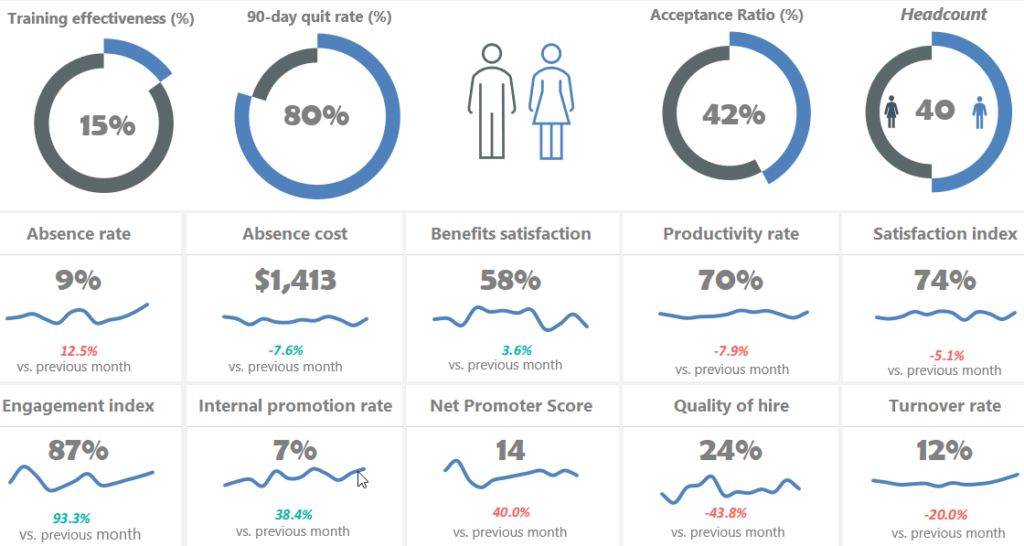
Download HR Dashboard Templates and Examples — Free for DEI HR Dashboards, Surveys & More
You can also create HR dashboards more easily with Business Intelligence (BI) Tools. Some of the top BI tools in the market include:
These typically are complicated, time-consuming, and require deep technical expertise and knowledge to create and maintain accurate and fresh HR analytics reports.
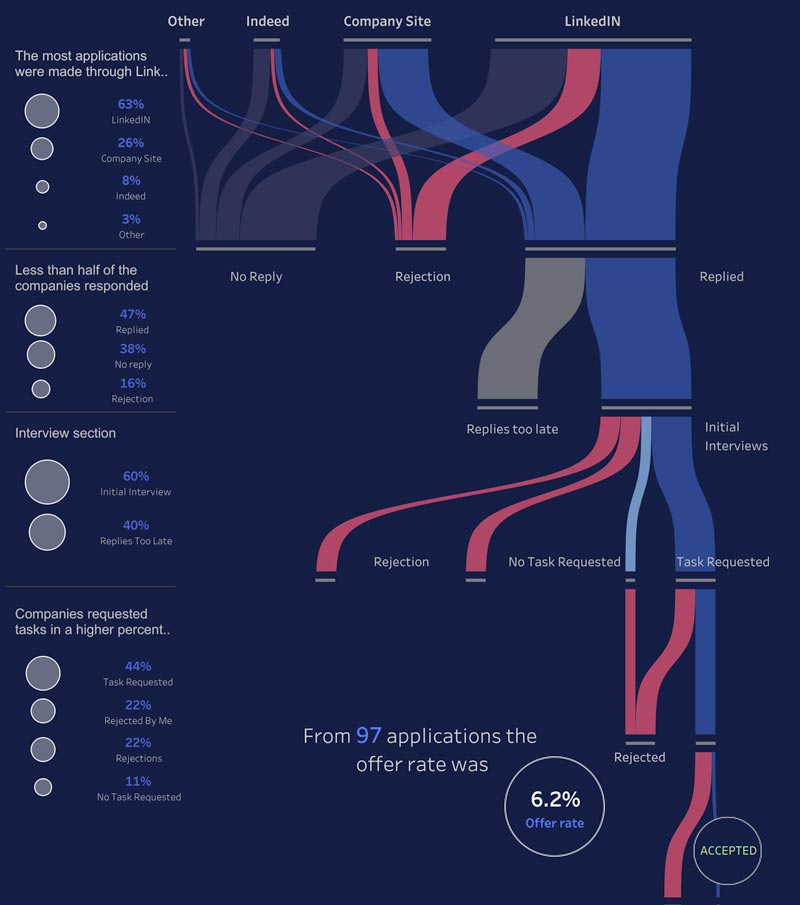
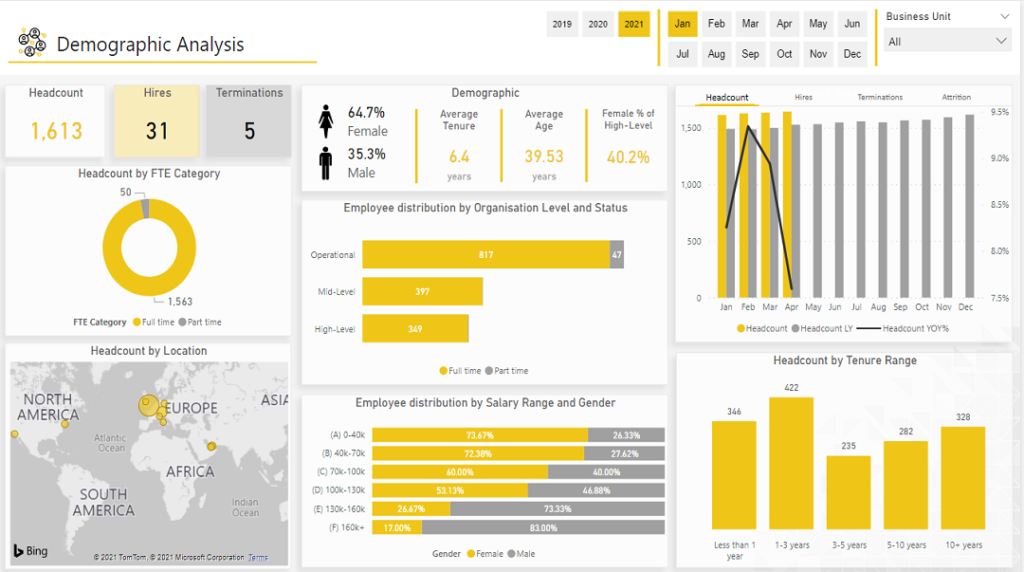
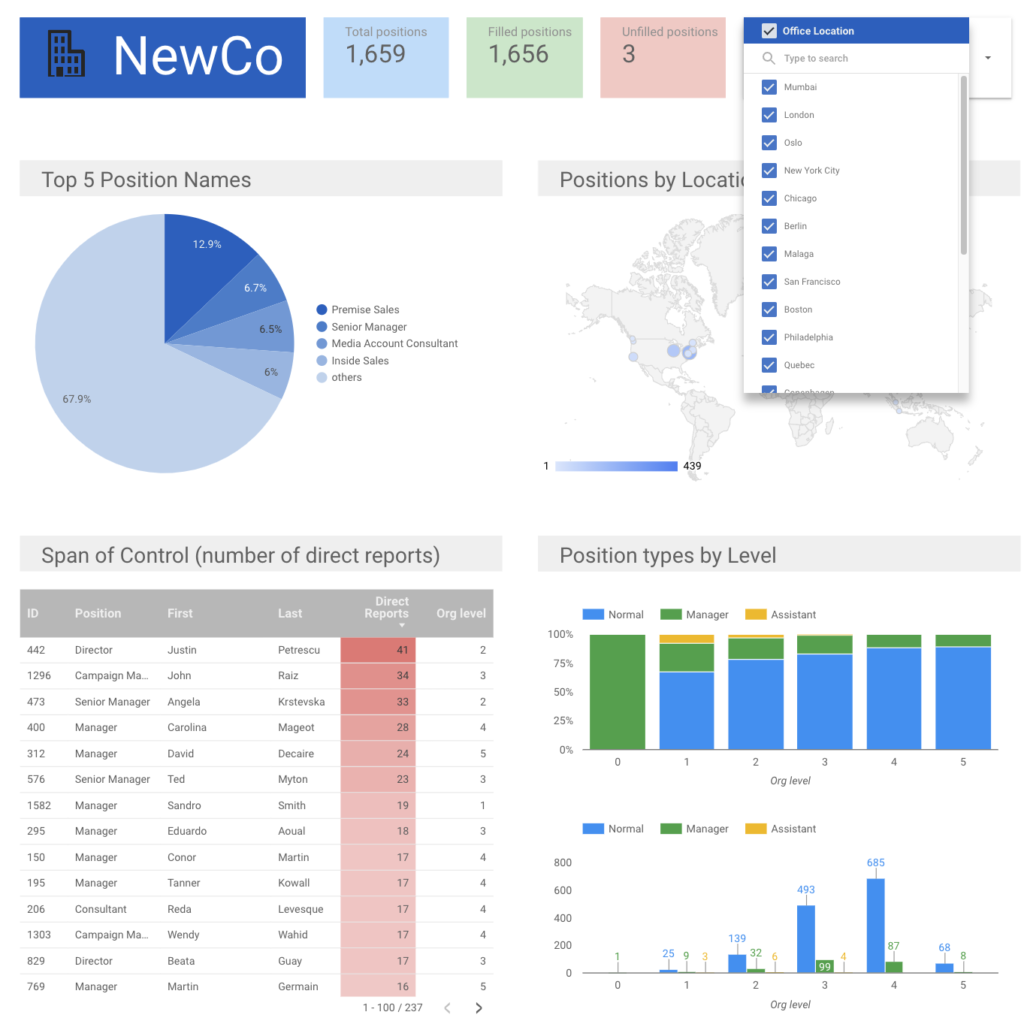
Next, you can explore an automated option with purpose-built HR dashboard software. An HR Dashboard software solution will automatically pull HR metrics to create people analytics and integrate them using your existing HR information systems (HRIS'/HRMS') by an expert team of HR data consultants and analysts.
Some of the most compelling and robust HR analytics and data visualization software create your HR dashboard for you. Here is an example HR dashboard builder by VC-backed company eqtble:

Not just that, but many automated HR dashboard solutions can save almost a full work day, increase visibility into workforce insights across the organization, and ensure correct metrics are calculated (no more messing with formulas in Excel).
Next we have another HR dashboard solution provider here which shows its Diversity Dashboard from VC-backed Employee Cycle.
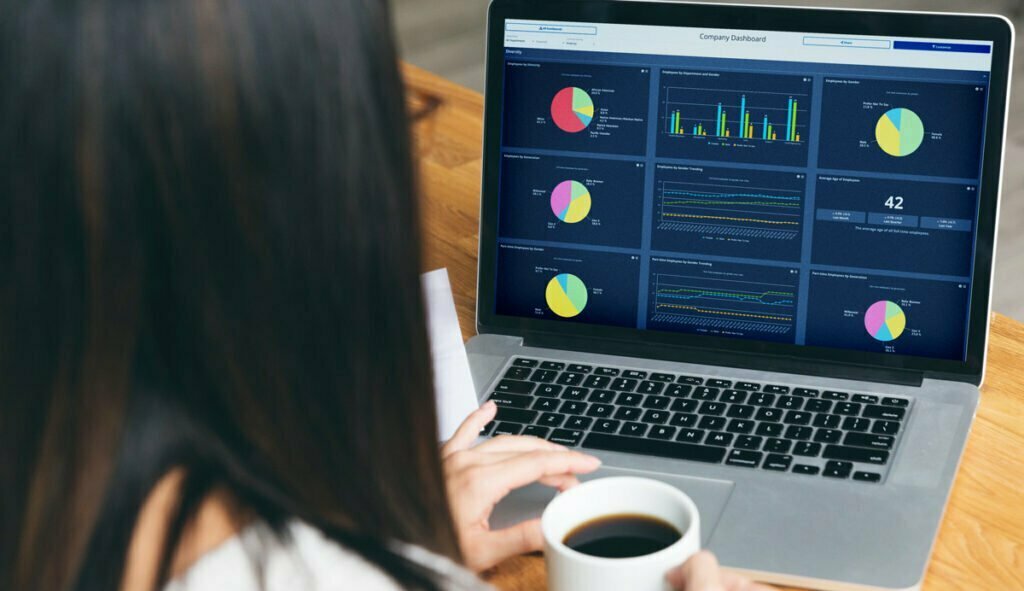
As you'll see the above two HR tech companies provide purpose-built HR analytics dashboards. They are essentially automated business intelligence and data visualization tools tailor-made for Human Resource teams without technical analytics capacities.
The next one up is a crowd favorite due to it's growing use cases and predictive analytics baked in. This one is from VC-backed Orgnostic, which takes a more sophisticated approach and is co-founded by a former Chief Human Resource Officer, Luka Babic.
The following HR dashboard example shows their people analytics solution helps to to discern key employee experience insights by looking at the company's employee engagement survey results by quarter:

With an HR dashboard, you can easily understand your attrition, recruiting efforts, and employee pulse. Plus, these platforms are built by experts, so you can be confident you're getting key insights and strategic recommendations.
Drive data-backed people decisions. Whether you're just getting your people analytics off the ground or tying into an established HR analytics department, you can use these solutions.
Related: Free People Analytics Masterclass (on-demand)
Transform your workforce by operationalizing HR data with an automated people analytics solution. For automated HR analytics and data visualization software solution, we have summarized the top people analytics solutions in this Top 10 List of People Analytics Software Solutions.
Get started with an HR dashboard and people analytics solution to improve your workforce by operationalizing HR data. This will save time for HR Generalists and HR Directors, and provide management with greater insight into how employees reach new levels of employee satisfaction, productivity, and a better employee experience.
See the Top 10 HR Analytics Software Solutions to find what fits your needs to get started today.
Be sure to subscribe to our weekly HR newsletter to be the 1st to get new information on upcoming HR webinars, new articles, guides, HR courses, and more!
7taps was used to create this snackable mico-course.
Define the desired outcomes of the employee experience transformation and create a plan to achieve them
Create a culture that encourages employees to participate in the transformation process and rewards them for their efforts
Ensure that employees have access to the resources they need to succeed, such as flexible working arrangements, health and wellness initiatives, and other benefits
Leverage technology to improve the efficiency of the transformation process and to provide employees with a better experience
Track progress throughout the transformation process to ensure that the desired outcomes are being achieved
Establishing a clear vision and strategy is essential for successful employee experience transformation as it provides direction and focus for the transformation process.
Quiz options:
If you're interested in in creating similar courses or using AI for inspiration to create training and development course materials like we did with this micro-course, get your free 14-day trial with our affiliate 7taps and explore 7taps AI.
As HR professionals, we play a critical role in shaping the work experiences of employees and building cultures that foster success and well-being. One approach that can help us in this mission is to focus on human-centered work.
At its core, human-centered work is work that puts the needs and well-being of people at the center of its focus. It recognizes that work is not just a means of income generation, but also a means for personal growth, self-expression, and enjoyment. It understands that work can provide opportunities for learning, perspective, self-affirmation, and making a positive impact on the world.
It also recognizes the importance of productivity and efficiency, but understands that traditional ways we work may not always be the most effective or sustainable. For example, the traditional model of working long hours and sacrificing personal time that could be enjoyed with our families for the sake of productivity is not sustainable in the long term, and can lead to burnout and reduced productivity. Instead, human-centered work seeks to find ways to increase productivity while also supporting the well-being and happiness of employees.
One way to do this is by adopting new productivity methods and technologies. Technology gives us unprecedented leverage, but it is only useful if it is surrounded by the right rules, mental models, policies and procedures, habits, and paradigms. Adopting new technologies can be challenging, as it requires change and can evoke fear, anxiety, overwhelm, and resistance.
However, with the right guidance and support, employees can learn to embrace change and find new ways of working that are more efficient and effective. Take, for example, AI tools like ChatGPT which has been trending since it came out last month. It uses technologies trained on a vast amount of knowledge, and is able to have a dialogue with you and even act as your personal assistant, editor, writer, and can be used to improve your own productivity as an extension of your own capabilities, done right. The following is an example prompt and response:
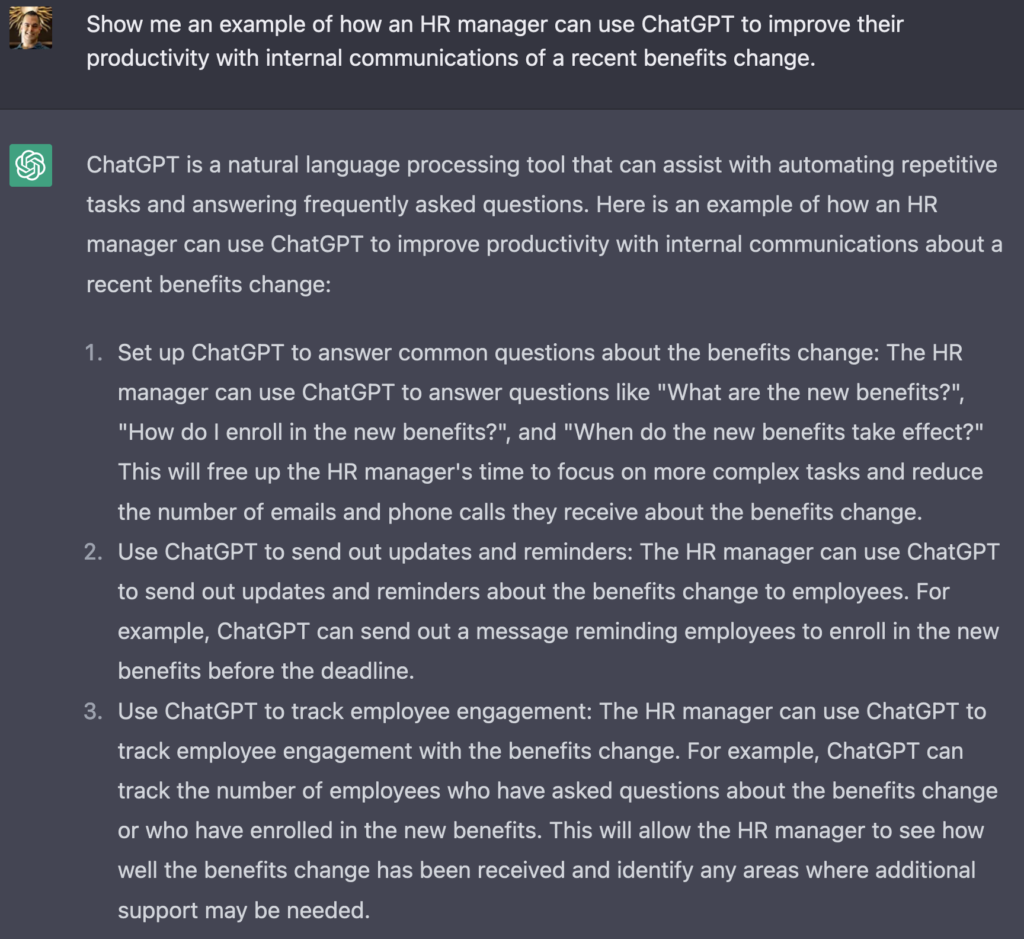
Overall, in this example of using AI and technology to boost productivity, ChatGPT can help the HR manager streamline their internal communications about the benefits change and reduce the time they spend answering questions and sending updates. This will allow them to be more productive and focus on other important tasks.
As HR professionals, it is our responsibility to help employees understand themselves, their values, and their goals, and to guide them in finding work that is meaningful and fulfilling for them. This requires building cultures that support personal growth and development, and providing employees with the tools and resources they need to succeed. It also requires creating a sense of community and connection among employees, and fostering a culture of open communication and collaboration.
In addition to these internal factors, HR professionals also need to consider the external context in which work takes place. This includes understanding the needs and expectations of customers and clients, as well as the impact of work on the broader community and society. By taking a holistic approach to work, HR professionals can help employees find purpose and meaning in their work, and contribute to the greater good.
In conclusion, human-centered work is a vital concept for HR professionals to consider as we strive to create cultures that support the success and well-being of employees. By focusing on personal growth, productivity, and a holistic approach to work, we can help employees find meaning and fulfillment in their work and contribute to a more peaceful and just society. So, it is very important for HR professionals to understand the concept of human-centered work and how to implement it in their organization.
The human resources industry is full of jargon. Sometimes it can feel like HR professionals are speaking a different language. If you're new to the HR field, or you're looking for a refresher on HR terminology, this guide is for you.
The HR industry is full of jargon. We hope you enjoyed this HR Glossary, which breaks down commonly used HR terms and phrases. It was created to help those seeking leadership and People roles in human resources, from students to executives, in order to better understand HR industry terminology.
Want to read what thousands of HR leaders from around the world are reading and watching? Subscribe to our newsletter today!
Looking for some good HRM eBooks to help you learn more about the topic? Look no further! Here are 235 great options from bookboon that are bite-sized for busy people leaders.
There are a lot of different aspects to human resources management (HRM), and it can be difficult to know where to start when trying to learn more about the topic. However, there are a few key resources that can help get you started on your journey to becoming an HR expert. One great way to learn more about HR is to read bite-sized eBooks on the subject. This way, you can learn about a specific topic without feeling overwhelmed by a long, dense book.
You can download and read books on just about anything on Human Resource Management and other subjects, at a nominal cost or at no cost, depending. There are a lot of different eBooks available on HR, so you can pick and choose which topics you want to focus on. Another great way to learn more about HR is to attend webinars, explore and earn HR certification, and discover top online HR courses.
Check out these top HRM eBooks and Audio Books that are bite-sized for busy people leaders like yourself below.
In a recent webinar with Orgnostic People Analytics software, Luka Babic goes through a few challenges, data points on the importance of HR data by McKinsey, and the entire employee life cycle and his team's model for it. He then goes on to provide his insights when we asked him about employee experience transformation.
In a distributed world, HR data can help to
Organizations need to build, measure, and learn to succeed. The lean startup model has good learnings around this for further reading.


Answer (edited): I completely agree actually the point that it is very similar to customer experience. Employee experience transformation does require a cultural change, or at least the culture underlying or the baseline that exists and this is something that was very mind-boggling to me generally in most of the companies. When you think about all the other functions in the organization from the very onset of a startup or company, sales is going to be data-driven. Marketing is going to be data-driven. Product is going to be data-driven. Engineering is going to be data-driven. So, they're all usually data-driven, and companies that have all these components at the top management level, that are benefits to that.
You have all the ingredients to make the soup; quite often HR just doesn't "cross the chasm" — and HR remains the only sort of feeling-driven function — and that isn't ideal because it is not being factored properly by the rest of the executive leadership team and to an extent the result of talent as well. And I think that that's the kind of a chasm — HR leadership needs to adopt this kind of mindset, that we need to build a data-driven function... because management is usually appreciating that kind of approach.
It's just about being being as mindful about what are the things that you should measure (HR metrics) and actually having a framework in mind (like OKRs) so that when you're coming in to share HR insights with management, it make sense, and it's not just a bunch of random numbers, or HR dashboards that you're that you're pushing around, which will not benefit your data-driven agenda.
But it's a great point. I think it's a great point that is very similar to the customer experience transformation and and that kind of mindset shift among the organization, specifically HR management in this case.
Luka Babic is the co-founder and CEO of the Orgnostic people analytics platform. Prior to founding Orgnostic, Luka was the Head of People Ops/CHRO and member of the Board at the tech unicorn Infobip. Before that, Luka worked as a researcher at Harvard, and he combines his industry knowledge and his deep connection with the academic community to tackle the challenge of making HR a truly data-driven, strategic function.
Image source & credits: Luka Babic / Orgnostic
Consider exploring top people analytics software like Orgnostic as your source of truth for HR data—which is a prerequisite for employee experience transformation.
Good news! There are many ways to measure the value of diversity, equity, and inclusion initiatives. Bad news: it’s not easy to find accurate, comprehensive metrics for calculating the overall effectiveness of your DEI program. That’s particularly true when you’re measuring outcomes related to change management and cultural transformation.
That’s likely to change over the next few years, as more companies make DEI initiatives a core part of their business strategy. In the meantime, here we’ll look at a few key metrics you can use to measure the effectiveness of your DEI program.
To determine the ROI of DEI initiatives, you need to measure both business outcomes and employee perceptions. Here are a few metrics to measure each. You can find more HR metrics here.
Measuring the impact of DEI initiatives is challenging, but not impossible.
Keeping track of data is important for understanding the diversity of your workforce, seeing how your DEI efforts are doing over time, and measuring how your organization's DEI status compares to others in your industry.
Fortunately, there are solutions for many of these problems. For example, you can improve the validity and reliability of diversity data by standardizing how you collect it.
Over time, all these efforts should result in accurate, consistent data that can be used to:
To do that, you’ll need to measure both business outcomes and employee perceptions.
When trying to build a case for DEI investment, you’ll run into several common objections. This is primarily because diversity initiatives cost money but don’t generate revenue, at least not in the immediate term.
Before you can generate revenue from your diversity initiatives, you need to first spend money on implementing and nurturing them. These initial costs are usually a hindrance to investment, but a good ROI story can help overcome resistance.
Use statistics from leading companies to state your case if you don't have your own first-party data to back up your initiative. For example, companies with above-average gender and racial/ethnic diversity in leadership roles are eight times more likely to be in the top 10% of organizations for financial performance (DDI, 2020).
Co-create your DEI initiative with your team and leadership
This will require you to operationalize a culture of authentic collaboration by building trust with leadership and your team, as well as using your HR data to determine important DEI metrics with your people analytics journey.
JEDI (Justice, Equity, Diversity, and Inclusion) - JEDI is an acronym for inclusivity in the workplace. It focuses on justice, equity, diversity, and inclusion, ensuring that everyone is treated fairly and comfortable, with no discrimination.
Often times, DEI programs make an attempt to address this, but not comprehensively.